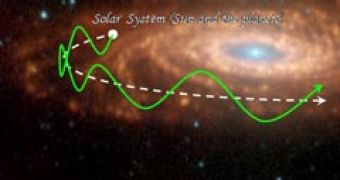There are immediate dangers menacing the human civilization, like terrorism and climate change. We may struggle to fight these issues which are in the end caused by the human race. But what can we do against the Universe?
In May 2007, a team led by Mikhail Medvedev at the University of Kansas emitted a novel theory aimed to explain the periodicity of mass extinctions on Earth, which occur about once every 62 million years. "The motion of the solar system exposes Earth to an onslaught of cosmic rays on a schedule that is synchronized to the mass extinctions.", signaled Adrian Melott, professor of physics and astronomy at KU.
The Milky Way galaxy appears to have a good side and a bad side. The bad aspect of the Milky Way would be its dorsal side. The team says that the leading, dorsal side of the Milky Way emits a shock wave as the galaxy travels through the universe. When the solar system periodically reaches the proximities of the dorsal boundary of the galaxy, about once every 64 million years, it is exposed (and Earth with it) to a huge amount of high-energy radiation induced by the galactic shock wave.
In other words, this periodic irradiation at each 64 million years wipes out many life forms on Earth. The team also informed when we're due for another trip to the wrong side. "We've just passed the mid-plane of the galaxy. We're on the way up and we'll reach a peak in about 10 or 12 million years. That's when the radiation should start getting bad again -- if our idea is right. As for the next die-off, there is plenty of time to prepare," said Melott.
"From what I gathered, the cosmic radiation received at the northernmost point of our oscillation would not be outright deadly. Level of CR would only be a few times higher than normal. What he seems to indicate to me is that over millions of years this is a long term stress on the biosphere which may make other events like volcanic eruptions and asteroid impacts all the more catastrophic." said Medvedev.
"There are some hints that there were episodes of increased diversification following the extinction episodes. Maybe these can be attributed to "good" mutations (thus supporting the CR hypothesis), though other explanations are equally possible." he added.

 14 DAY TRIAL //
14 DAY TRIAL //